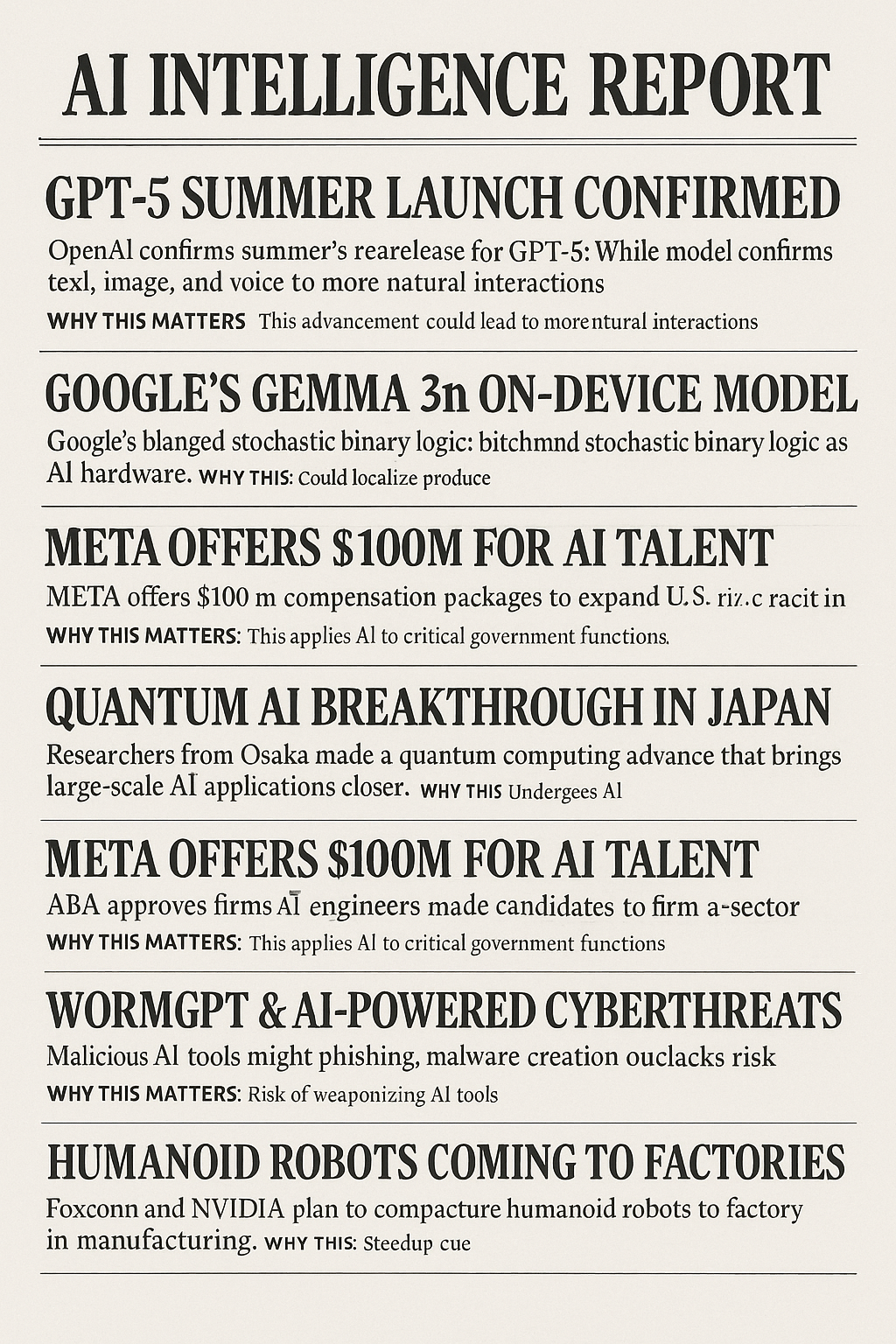🧠 Daily AI News Roundup – June 28, 2025

🚀 OpenAI Confirms GPT-5 Summer Launch
OpenAI CEO Sam Altman announced on the inaugural OpenAI Podcast that GPT-5 will arrive “probably sometime this summer.” This next-gen model, part of the $500 billion Project Stargate, leverages gigawatt-scale compute and early feedback indicates it outperforms GPT-4 with unified multimodal (text, image, voice) processing and extended context windows.
Why this matters: GPT-5 ushers in a new era of AI performance and brings us closer to Artificial General Intelligence (AGI), powering more natural—and powerful—human-computer interactions.
📱 Google Unveils Gemma 3n: Multimodal On-Device AI
Google released Gemma 3n, a lightweight multimodal model for smartphones and laptops. Built on the MatFormer architecture with Per-Layer Embeddings (PLE), it natively handles text, images, audio, and video in 35 languages—yet fits in just 2 GB of memory.
Why this matters: By democratizing advanced AI on consumer devices, Gemma 3n reduces reliance on the cloud, cuts latency, and bolsters user privacy.
🔌 China Mass-Produces World’s First Non-Binary AI Chips
Beihang University’s team pioneered a “non-binary” AI chip using Hybrid Stochastic Numbers (HSN), blending binary logic with stochastic computing. These chips, now mass-produced in China, slash power use while maintaining fault tolerance—bypassing U.S. export controls.
Why this matters: Hardware breakthroughs like HSN chips enable energy-efficient AI at scale and strengthen China’s independence in critical AI infrastructure.
⚛️ Osaka Researchers Break New Ground in Quantum AI
A team at the University of Osaka introduced “level-zero” magic-state distillation, dramatically cutting qubit overhead for fault-tolerant quantum computers. This method reduces noise susceptibility and resource demands by dozens of times over traditional approaches.
Why this matters: Practical, large-scale quantum computing is one step closer, promising exponential speedups for AI tasks currently limited by classical hardware.
🤝 Meta’s $100 M Engineer Recruitment Push
Sam Altman revealed Meta’s bid to lure top OpenAI talent with compensation packages worth up to $100 million. This drive—which coincides with Meta’s $14 billion Scale AI investment—underscores the fierce battle for AI expertise.
Why this matters: Talent wars show that in AI, people are as valuable as patents or data, and aggressive recruitment can tip the competitive balance among tech giants.
🩺 FDA Debuts “Elsa” for Regulatory AI
The U.S. FDA launched “Elsa,” its first in-house AI platform for summarizing drug-safety reports, comparing product labels, and auto-generating analysis code. This marks the agency’s push to integrate AI in regulatory workflows.
Why this matters: Government adoption of AI sets precedents for large-scale, mission-critical deployments—reshaping how public institutions process and oversee vital data.
🔬 FDA Grants Breakthrough Status to AI Cancer Tools
The FDA awarded Breakthrough Device designation to Paige PanCancer Detect—an AI capable of spotting multiple cancer types in tissue slides—and CLAIRITY BREAST, which predicts five-year breast-cancer risk from routine mammograms.
Why this matters: AI’s elevation to “breakthrough” status accelerates approval and adoption of life-saving diagnostics, moving healthcare toward earlier detection and personalized treatment.
🐛 WormGPT Variants Weaponize LLMs
Security researchers uncovered new WormGPT strains—malicious forks of models like Grok and Mixtral—used to craft phishing campaigns, generate malware, and bypass safety filters. This highlights the dark side of open-source AI.
Why this matters: As AI tools become more accessible, robust cybersecurity and governance frameworks are critical to prevent large-scale abuse.
🎭 AI-Driven Misinformation in Conflict Zones
Deepfake videos of the Iran–Israel conflict went viral this week, fueling misinformation. Surveys show 7 % of global users now rely on AI chatbots for news, raising concerns about propaganda via synthetic media.
Why this matters: The weaponization of AI in information warfare undermines trust in media and demands new detection tools and digital-literacy initiatives.
🤖 Humanoid Robots to Join Foxconn Production
Foxconn and NVIDIA plan to deploy humanoid robots on electronics assembly lines by Q1 2026. These robots—powered by advanced on-device AI—will handle cable insertion, part placement, and quality checks.
Why this matters: The integration of humanoid robots marks a pivotal shift in manufacturing automation, potentially reshaping labor needs and production efficiencies.
🤖 Google’s Gemini Robotics On-Device
DeepMind’s Gemini Robotics On-Device model now runs entirely offline on robots, enabling dexterous tasks like unzipping bags and folding clothes from natural-language instructions.
Why this matters: Localized robotic intelligence ensures reliable performance in connectivity-challenged environments and expands the scope of autonomous applications.
🌟 Teen Innovator Pranjali Awasthi Raises Delv.AI to $12 M
Sixteen-year-old Pranjali Awasthi’s AI research platform Delv.AI—designed to auto-summarize and extract insights—now values at $12 million. Her next project, Dash, aims to give AI “hands” for physical actions.
Why this matters: Youth-led startups demonstrate AI’s accessibility and hint at future innovations at the intersection of digital intelligence and real-world actuation.
🔑 Key Takeaway: Today’s headlines spotlight AI’s tectonic shifts in hardware, software, regulation, and real-world impact—underscoring a future where compute breakthroughs, talent battles, and ethical guardrails will define the next wave of innovation.
Recommended AI tools
Sora
Video Generation
Create stunning, realistic videos and audio from text, images, or video—remix and collaborate with Sora, OpenAI’s advanced generative video app.
Google Gemini
Conversational AI
Your everyday Google AI assistant for creativity, research, and productivity
Perplexity
Search & Discovery
Clear answers from reliable sources, powered by AI.
DeepSeek
Conversational AI
Efficient open-weight AI models for advanced reasoning and research
Windsurf (ex Codium)
Code Assistance
Tomorrow’s editor, today. The first agent-powered IDE built for developer flow.
Grok
Conversational AI
Your cosmic AI guide for real-time discovery and creation


